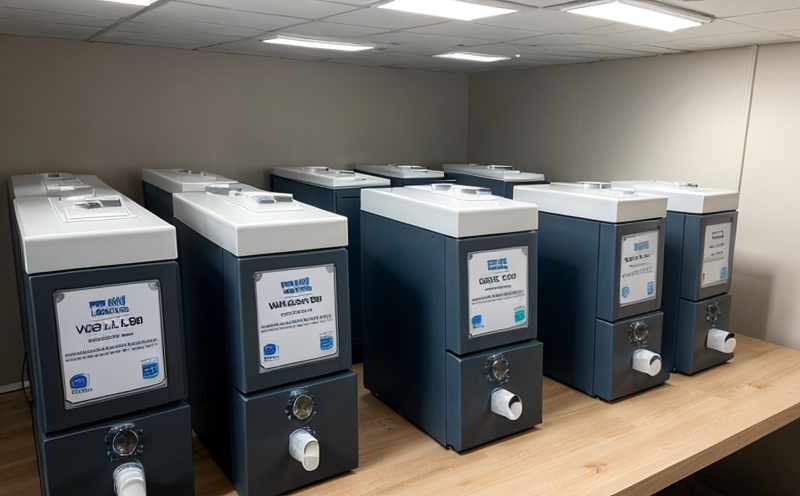ASTM E1333 Large chamber method for measuring formaldehyde emissions
The ASTM E1333 standard provides a large chamber method to measure formaldehyde emissions from materials and products. This method is widely used in the textile, furniture, and building industries to ensure compliance with emission limits set by regulatory authorities.
Formaldehyde is a volatile organic compound (VOC) that can be harmful when present at high concentrations. The ASTM E1333 method uses a large chamber to simulate real-world conditions under which materials or products are exposed to air, allowing the formaldehyde emitted from them to be measured accurately and precisely.
The testing process involves placing the specimen inside a climate-controlled large chamber. Over a specified time period, the chamber is saturated with a known amount of air. The air is then drawn out through a filter that captures any formaldehyde present. This filtered air is analyzed using either gas chromatography or other analytical methods to determine the concentration of formaldehyde.
Testing according to ASTM E1333 ensures that products and materials meet stringent emission limits set by various regulatory bodies like the California Air Resources Board (CARB) and European Union regulations. This testing method helps manufacturers ensure their products are safe for consumers while also complying with environmental standards.
The large chamber used in this test is specifically designed to simulate real-world conditions, providing a more accurate representation of how materials perform under actual use. The size and design of the chamber allow for sufficient air circulation, ensuring that formaldehyde emissions from all parts of the specimen are captured accurately.
Preparation of specimens before testing according to ASTM E1333 is critical. Specimens must be representative of the product or material being tested, with no parts left out that could affect the emission rate. The preparation process includes ensuring consistent moisture content and temperature conditions, which can influence formaldehyde emissions.
Once prepared, specimens are placed inside a climate-controlled large chamber. The chamber is then sealed and exposed to controlled environmental conditions for a specified period of time. During this time, air is drawn out through a filter to capture any emitted formaldehyde. After the exposure period, the sample is analyzed using gas chromatography or other analytical methods.
The results of the ASTM E1333 test are reported in terms of parts per million (ppm) of formaldehyde released from the specimen under specified conditions. These results help manufacturers understand the emission levels of their products and make necessary adjustments to reduce emissions if needed.
Compliance with ASTM E1333 is crucial for ensuring product safety and environmental responsibility. Many industries rely on this standard to meet regulatory requirements and maintain consumer trust. By adhering to this method, manufacturers can demonstrate their commitment to producing high-quality products that are both safe and environmentally friendly.
Applied Standards
The ASTM E1333 large chamber method is widely recognized for measuring formaldehyde emissions from various materials and products. Some of the key standards that this method supports include:
- ASTM E1333-08(2017): This version of the standard outlines detailed procedures for measuring formaldehyde emissions using a large chamber.
- EN 14956: European standard that aligns closely with ASTM E1333, ensuring compatibility and comparability between different regions.
- CAL/ARP CARB: California Air Resources Board regulations often require compliance with this method to ensure products meet strict formaldehyde emission limits.
These standards provide a consistent framework for testing formaldehyde emissions, ensuring that results are reliable and comparable across different laboratories and industries. Compliance with these standards is essential for manufacturers aiming to meet regulatory requirements and maintain product safety.
Customer Impact and Satisfaction
The ASTM E1333 large chamber method plays a crucial role in enhancing customer satisfaction by ensuring that products comply with strict formaldehyde emission limits. By adhering to this testing protocol, manufacturers can:
- Ensure compliance with regulations: Meeting regulatory requirements is essential for market access and avoiding penalties.
- Enhance product quality: Testing according to ASTM E1333 helps identify potential issues early in the development process, leading to higher-quality products.
- Build consumer trust: By demonstrating commitment to safety and environmental responsibility, manufacturers can build strong relationships with their customers.
The results of ASTM E1333 testing are widely recognized by regulatory bodies and consumers alike. This recognition enhances the reputation of companies that adhere to this standard, leading to increased customer satisfaction and loyalty.
Use Cases and Application Examples
| Application Case | Description |
|---|---|
| Furniture Manufacturing | ASTM E1333 is used to test formaldehyde emissions from wooden furniture, ensuring compliance with CARB and other regulatory standards. |
| Textile Production | This method helps textile manufacturers ensure that their products meet formaldehyde emission limits set by various regulatory bodies. |
| Flooring Products | The ASTM E1333 large chamber method is used to test formaldehyde emissions from wooden flooring, ensuring compliance with international standards. |
| Carpet Manufacturing | This testing protocol helps carpet manufacturers ensure that their products meet strict formaldehyde emission limits set by regulatory authorities. |
| Fabric Coatings | The ASTM E1333 large chamber method is used to test the formaldehyde emissions from fabric coatings, ensuring compliance with international standards. |
| Insulation Materials | This testing protocol helps insulation manufacturers ensure that their products meet strict formaldehyde emission limits set by regulatory authorities. |
The ASTM E1333 large chamber method is widely used across various industries to ensure compliance with formaldehyde emission standards. This table provides a few examples of how this testing protocol is applied in different sectors, ensuring that products are safe for consumers and environmentally responsible.





